BOJ relaxes grip on rates as end to yield control looms

Japanese national flag is hoisted atop the headquarters of Bank of Japan in Tokyo, Japan Sept 20, 2023. REUTERS/Issei Kato/File photo
TOKYO – The Bank of Japan further loosened its grip on long-term interest rates by tweaking its bond yield control policy again on Tuesday, taking another small step towards dismantling the past decade’s massive monetary stimulus.
The nine-member board also revised up its price forecasts to project inflation well exceeding its 2 percent target this year and next, underscoring a growing conviction that conditions for phasing out ultra-loose monetary policy are falling into place.
But the yen tumbled against the dollar after the decision as traders focused on the BOJ’s dovish pledge to “patiently” maintain its extremely accommodative policy and forecast for inflation to slow back below 2 percent in 2025.
“It looks like the BOJ is taking the ‘softly, softly’ approach here,” said Kyle Rodda, senior financial market analyst at Capital.com in Melbourne. “The incrementalism was perhaps a surprise to markets given the speculation of an actual tweak.”
As widely expected, the BOJ maintained its -0.1 percent target for short-term interest rates and that for the 10-year government bond yield around 0 percent set under yield curve control (YCC).
READ: Japan’s 10-year yield hits new decade high on BOJ tweak speculation
But the BOJ re-defined 1 percent as a loose “upper bound” rather than a rigid cap and removed a pledge to defend the level with offers to buy unlimited amount of bonds.
“Given extremely high uncertainties over the economy and markets, it’s appropriate to increase flexibility in the conduct of yield curve control,” the BOJ said in a statement announcing the decision.
Rising global bond yields, persistent inflation
The decision highlights how rising global bond yields and persistent inflation are making it increasingly difficult for the BOJ to maintain its controversial bond yield control.
“(The) BOJ will buy some bonds around that (1 percent) level but not unlimited and they’ve shown their hand. Through all the linguistic contortions, the fact is that they are dismantling YCC,” said Tom Nash, portfolio manager at UBS Asset Management in Sydney, who is positioned for a rise in Japanese yields.
“A yield cap isn’t a yield cap if you change it every time the market gets close.”
Under criticism that its heavy defense of the cap is causing market distortions and an unwelcome yen fall, the BOJ raised its de-facto ceiling for the yield to 1 percent from 0.5 percent in July.
Since then, rising global bond yields have put the BOJ in a tight spot with the 10-year JGB yield rising to a fresh decade high of 0.955 percent hours before Tuesday’s decision.
While the tweak could reduce the need for the BOJ to ramp up bond buying, it may cement market expectations of a near-term end to YCC and negative interest rates.
Exit from easy monetary policy
Markets are focusing on Governor Kazuo Ueda’s post-meeting news conference for clues on how soon the bank could move towards a full-fledged exit from easy monetary policy.
Inflation stayed above the BOJ’s 2 percent target for the 18th straight month in September. Surveys have shown heightening inflation expectations, which lower the real cost of borrowing.
READ: Core inflation in Japan’s capital unexpectedly accelerates
But the BOJ has remained a dovish outlier among global central banks that have mostly hiked rates aggressively in recent years to combat rampant inflation, haunted by a legacy of premature tightening that had drawn criticism from politicians for delaying an exit from chronic deflation.
Despite repeated assurances by Ueda that ultra-low interest rates will stay, markets are already predicting a policy shift early next year.
Nearly two-thirds of economists polled by Reuters expect the BOJ to end negative rates next year.